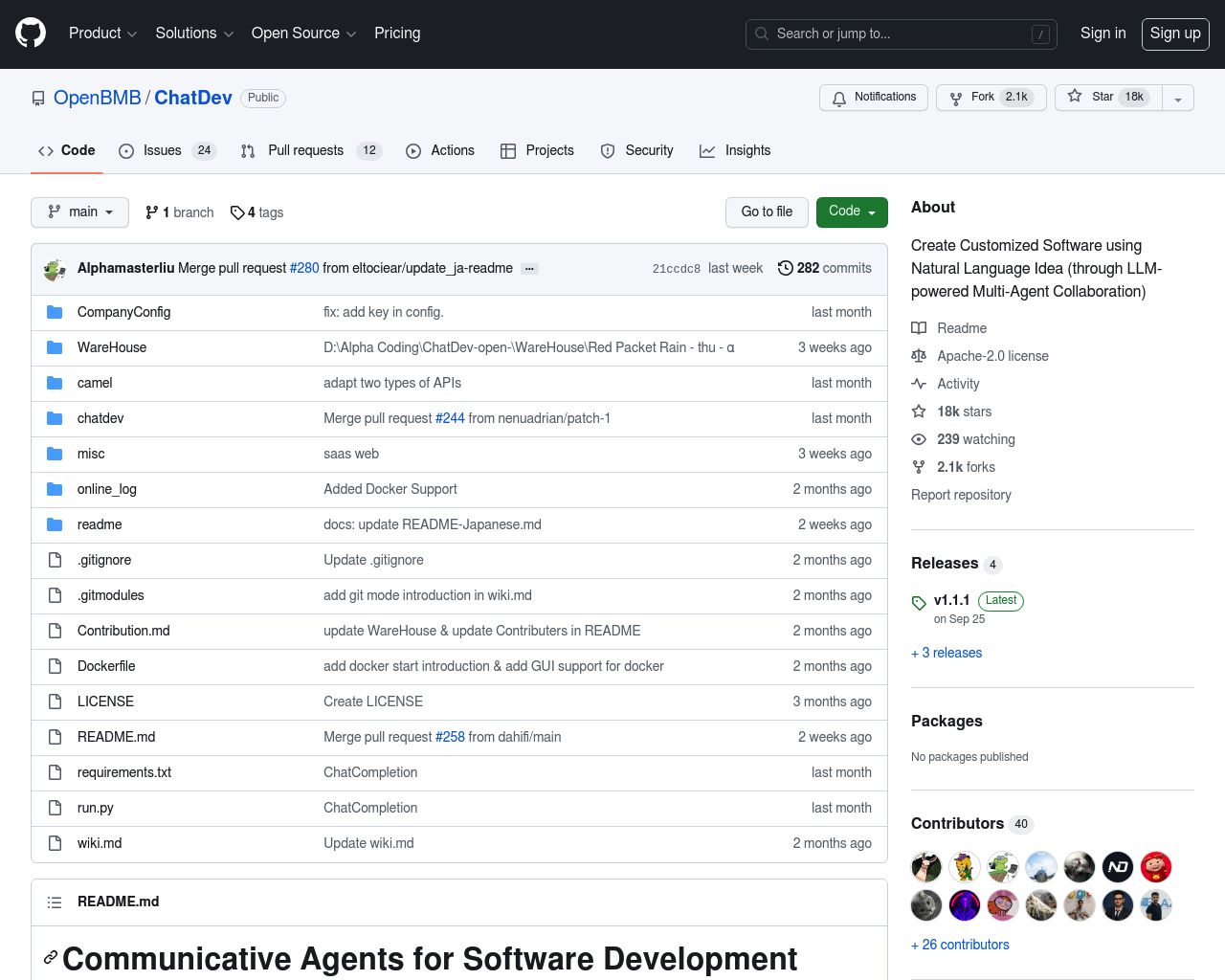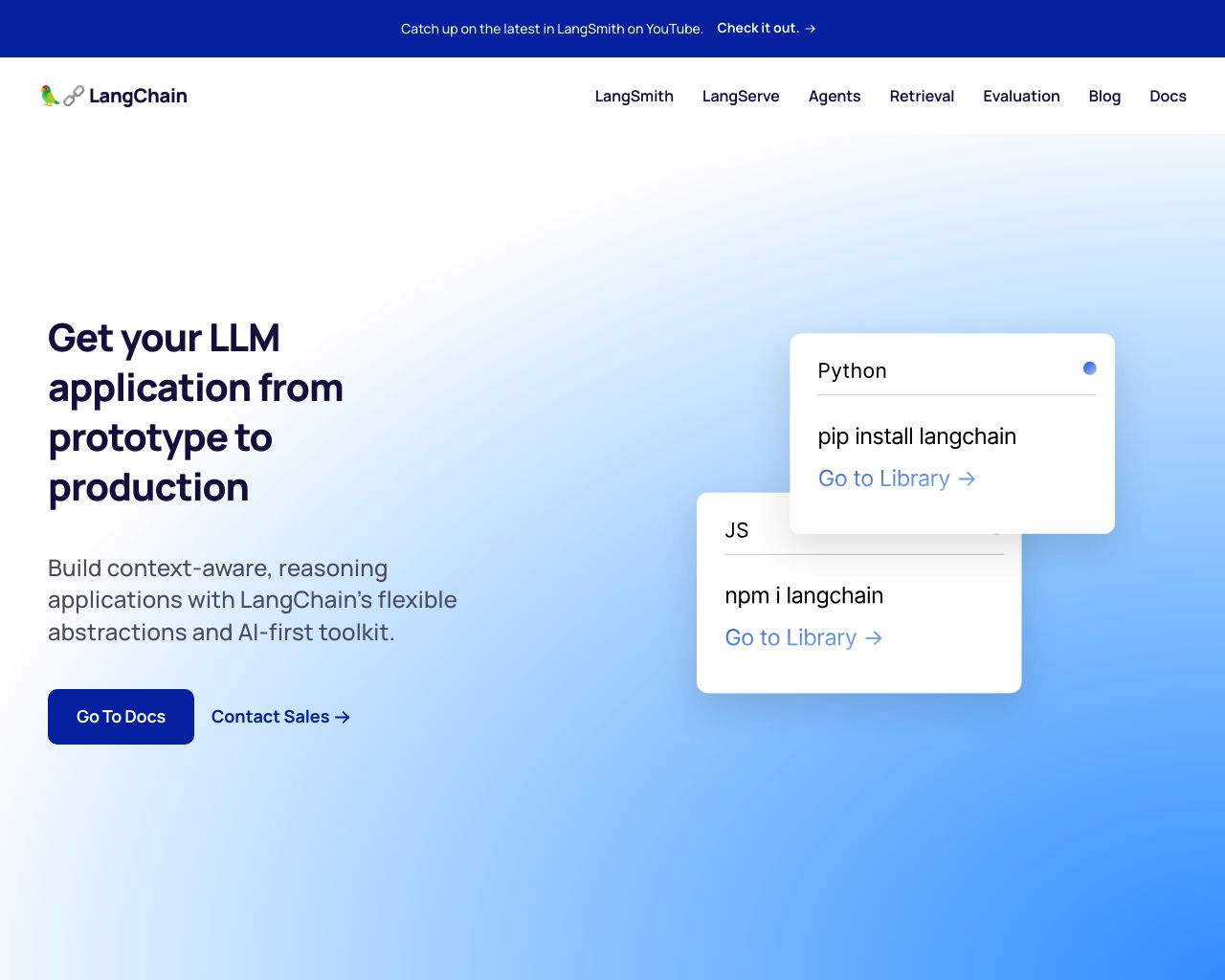AI-driven software development has transformed from a futuristic concept to a present-day reality. ChatDev and LangChain stand at the forefront of this revolution, each offering unique approaches to harnessing the power of large language models (LLMs) for creating sophisticated applications. This comparison delves into the strengths and limitations of these innovative platforms, exploring how they streamline the development process, enhance productivity, and push the boundaries of what’s possible with AI.
Whether you’re a seasoned developer seeking to automate complex tasks or a business leader looking to integrate AI into your workflow, understanding the capabilities of ChatDev, LangChain, and the emerging alternative SmythOS will equip you with the knowledge to make informed decisions in this rapidly evolving field.
ChatDev Overview
ChatDev revolutionizes software development by automating the entire process using large language models (LLMs). This open-source framework simulates a virtual software company, employing multiple AI agents to collaboratively tackle complex programming tasks.
The platform leverages a team of specialized AI agents, each fulfilling distinct roles such as CEO, CTO, programmer, and tester. These agents communicate through a structured chat chain, breaking down software development into manageable tasks. ChatDev’s approach enables rapid prototyping and development, potentially creating simple applications in minutes for a fraction of traditional costs.
ChatDev revolutionizes software development by automating the entire process using large language models (LLMs)… employing multiple AI agents to collaboratively tackle complex programming tasks.
ChatDev excels in providing transparency throughout the development process. Its web app allows users to replay entire conversations between agents, offering insights into decision-making and problem-solving strategies. The framework utilizes Camel-AI for inter-agent communication and implements innovative mechanisms like thought instructions and self-reflection to enhance code quality and minimize errors.

While ChatDev offers powerful capabilities, it faces challenges in scalability and flexibility. The rigid structure of its simulated company can create bottlenecks in more complex projects. Additionally, the platform currently lacks features like a visual builder or no-code editor, which may limit accessibility for non-technical users.
ChatDev excels in providing transparency throughout the development process… allowing users to replay entire conversations between agents, offering insights into decision-making and problem-solving strategies.
ChatDev integrates with version control systems like Git, enabling collaborative and concurrent development practices. However, it does not offer extensive integrations with other tools or APIs, potentially limiting its applicability in diverse development ecosystems. Despite these limitations, ChatDev’s innovative approach to AI-driven software development positions it as a noteworthy tool for developers and researchers exploring the frontiers of automated programming.
LangChain Overview
LangChain empowers developers to build sophisticated applications powered by large language models (LLMs). This open-source framework simplifies the creation of AI-driven solutions by providing modular components and tools for each stage of the LLM application lifecycle.
At its core, LangChain offers a comprehensive suite of libraries and tools for LLM application development. The framework includes LangChain Expression Language (LCEL) for declarative component chaining, LangGraph for building stateful multi-actor systems, and LangServe for deploying LangChain applications as REST APIs. These tools enable developers to create, test, and deploy AI agents with capabilities ranging from natural language processing to complex problem-solving.
LangChain empowers developers to build sophisticated applications powered by large language models (LLMs). This open-source framework simplifies the creation of AI-driven solutions…

LangChain excels in providing developers with flexibility and control. Its modular design allows for easy customization and integration with various LLMs, data sources, and third-party tools. The framework supports streaming outputs, structured data handling, and advanced retrieval techniques like retrieval augmented generation (RAG). These features enable the creation of AI agents capable of maintaining context, processing multiple input types, and delivering more accurate and relevant responses.
LangChain excels in providing developers with flexibility and control. Its modular design allows for easy customization and integration with various LLMs, data sources, and third-party tools.
While LangChain offers powerful capabilities, it requires a solid understanding of Python and LLM concepts. The learning curve can be steep for those new to AI development. Additionally, as an open-source project, LangChain may lack some of the polished user interfaces and enterprise-grade support found in commercial alternatives. Users must also carefully manage their own infrastructure and scaling needs, as LangChain primarily focuses on providing development tools rather than hosting solutions.
LangChain’s ecosystem continues to grow, with active community contributions and regular updates. The framework’s emphasis on composability and integration positions it as a versatile choice for developers seeking to push the boundaries of what’s possible with LLMs. As AI technology evolves, LangChain’s adaptability and extensibility make it a compelling option for those looking to stay at the forefront of AI application development.
Feature Comparison
ChatDev and LangChain offer distinct approaches to AI-driven software development, each with unique strengths and limitations. ChatDev simulates a virtual software company using multiple AI agents, while LangChain provides a modular framework for building LLM-powered applications.
ChatDev excels in automating the entire software development lifecycle through its multi-agent system. Its agents collaborate to handle tasks from initial design to final product delivery, potentially creating simple applications in minutes. However, ChatDev lacks a visual builder or no-code editor, which may limit accessibility for non-technical users. The platform’s rigid structure can also create bottlenecks in more complex projects.
In contrast, LangChain offers greater flexibility and customization options. Its modular design allows for easy integration with various LLMs, data sources, and third-party tools. LangChain supports advanced features like streaming outputs and retrieval augmented generation (RAG), enabling the creation of more sophisticated AI agents. However, LangChain requires a solid understanding of Python and LLM concepts, presenting a steeper learning curve for newcomers to AI development.
Feature Comparison Table
| ChatDev | LangChain | SmythOS | |
|---|---|---|---|
| CORE FEATURES | |||
| Visual Builder | ❌ | ❌ | ✅ |
| No-Code Options | ❌ | ❌ | ✅ |
| Bulk Work | ❌ | ✅ | ✅ |
| Agent Work Scheduler | ❌ | ❌ | ✅ |
| SECURITY | |||
| Constrained Alignment | ❌ | ❌ | ✅ |
| IP Control | ❌ | ❌ | ✅ |
| COMPONENTS | |||
| Zapier APIs | ✅ | ❌ | ✅ |
| Data Lakes | ❌ | ❌ | ✅ |
| DEPLOYMENT OPTIONS (EMBODIMENTS) | |||
| Deploy as Webhook | ✅ | ❌ | ✅ |
| Staging Domains | ❌ | ❌ | ✅ |
| Production Domains | ❌ | ❌ | ✅ |
| Deploy as Scheduled Agent | ❌ | ❌ | ✅ |
| Scalability | ❌ | ✅ | ✅ |
| DATA LAKE SUPPORT | |||
| Hosted Vector Database | ❌ | ❌ | ✅ |
| Sitemap Crawler | ❌ | ❌ | ✅ |
| YouTube Transcript Crawler | ❌ | ❌ | ✅ |
| URL Crawler | ✅ | ❌ | ✅ |
| Word File Support | ✅ | ❌ | ✅ |
| TXT File Support | ❌ | ✅ | ✅ |
Best Alternative to ChatDev and LangChain
SmythOS stands out as the superior alternative to ChatDev and LangChain for AI agent development and deployment. Our platform combines powerful features with unmatched ease of use, empowering users to create sophisticated AI solutions without extensive coding knowledge.
Unlike ChatDev’s rigid multi-agent system or LangChain’s code-heavy approach, SmythOS offers a visual drag-and-drop interface that simplifies AI agent creation. This intuitive design allows both technical and non-technical users to build complex workflows effortlessly, connecting various data sources, APIs, and AI models with ease.
SmythOS offers a visual drag-and-drop interface that simplifies AI agent creation… allowing both technical and non-technical users to build complex workflows effortlessly
SmythOS excels in versatility and scalability. While ChatDev focuses on simulating a software development process and LangChain requires significant programming expertise, our platform supports a wide range of use cases across industries. From chatbots and virtual assistants to data analysis tools and automated workflows, SmythOS adapts to diverse business needs without compromising on performance or functionality.
Security and deployment options set SmythOS apart from competitors. We offer robust features like constrained alignment, data encryption, and IP control, ensuring your AI agents operate within defined parameters and comply with security standards. Our platform also provides flexible deployment options, including API endpoints, webhooks, scheduled agents, and integration with popular AI platforms, giving you complete control over how and where your AI solutions are implemented.
SmythOS offers robust features like constrained alignment, data encryption, and IP control… providing flexible deployment options
By choosing SmythOS, you gain access to a comprehensive ecosystem for AI agent development that combines power, flexibility, and user-friendliness. Our platform empowers you to harness the full potential of AI technology, driving innovation and efficiency across your organization faster and more effectively than ever before.
Conclusion
ChatDev and LangChain offer innovative approaches to AI-driven software development, but SmythOS emerges as the superior choice for businesses seeking a comprehensive, user-friendly AI solution. While ChatDev excels in automating software development and LangChain provides flexibility for experienced developers, SmythOS combines the best of both worlds with added benefits.
SmythOS’s drag-and-drop interface and no-code options make AI development accessible to a broader audience, addressing the limitations of both ChatDev and LangChain in terms of user-friendliness. Our platform’s extensive integration ecosystem, supporting over 300,000 integrations, surpasses the capabilities of both alternatives, allowing for seamless incorporation into existing workflows.
Unlike ChatDev’s rigid structure and LangChain’s steep learning curve, SmythOS offers unparalleled versatility. We provide multi-agent orchestration, versatile deployment options, and support for various AI models, enabling users to create sophisticated AI solutions without extensive technical expertise. Our “Create Once, Deploy Anywhere” approach sets us apart, allowing businesses to leverage AI across multiple platforms effortlessly.
Experience the future of AI development with SmythOS. Explore our diverse range of AI-powered agent templates to jumpstart your projects, or dive into our comprehensive documentation to unlock the full potential of our platform. Ready to revolutionize your workflow? Create a free SmythOS account today and join the AI-powered productivity revolution.